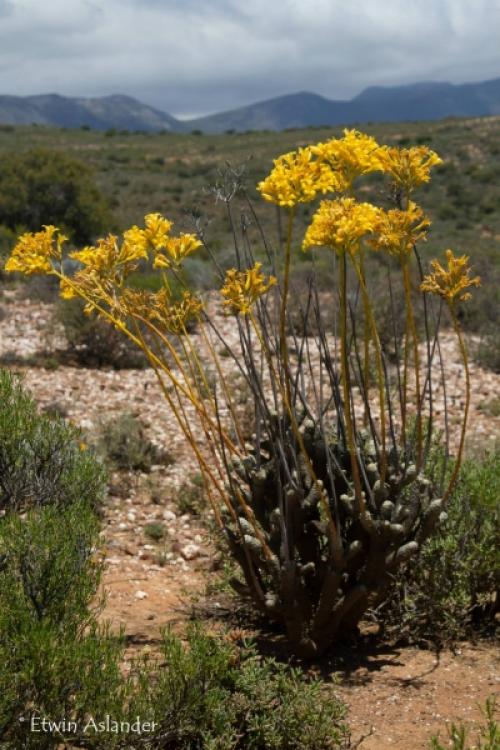CACALIOIDES (L.f.) Tölken, 1978 (engl./ fr.)
Synonyms :
Cacalia papillaris L. (1753) / Kleinia papillaris (L.) Haworth (1812) / Senecio papillaris (L.) Schulz-Bipontinus (1845) / Tylecodon papillaris (L.) G.D.Rowley (1979)
Distribution : SA (Western Cape); Succulent Karoo.
Description (according to Tölken, 1985, and E. van Jaarsveld in IHSP, 2003) :
Ascending branched shrubs to 50 cm tall with a single main branch to 5 cm in diameter with yellow grey peeling bark.
Branches 15 - 18 mm in diameter, grey-green with short phyllopodia 1 - 2 mm tall (often absent in older branches).
Leaves to 6.8 x 0.4 cm, crowded, glabrous (young glandular-hairy), grey-green, linear, terete or slightly grooved above, slightly constricted towards the base, acute or cuspidate.
Inflorescences erect thyrses to 55 cm tall with up to 7 spreading monochasia, peduncle to 7mm in diameter at the base, glandular-hairy becoming glabrous, pedicels 7 mm.
Flowering time : Mid-summer.
-----------------------------------------------------------------------------------------------------------------------------
Cotyledon cacalioides L.f. (1781)
Cacalia papillaris L. (1753) / Kleinia papillaris (L.) Haworth (1812) / Senecio papillaris (L.) Schulz-Bipontinus (1845) / Tylecodon papillaris (L.) G.D.Rowley (1979)
Distribution : Afrique du Sud (Cap-Occidental) ; Karoo semi-désertique.
Description (selon E. van Jaarsveld dans IHSP, 2003) :
Buisson ascendant, ramifié, atteignant 50 cm de haut, avec une seule branche principale de 5 cm de diamètre, à l'écorce gris-jaune s'exfoliant.
Branches 15 - 18 mm de diamètre, gris-vert avec courts phyllopodia de 1 - 2 mm (souvent absents sur les plus vieilles branches).
Feuilles jusqu'à 6,8 x 0,4 cm, regroupées, glabres (les jeunes ayant des poils glandulifères), gris-vert, linéaires, de section presque ronde et courbées vers l'intérieur, dessus parfois légèrement canaliculé.
Inflorescences en thyrses érigés atteignant 55 cm de haut, ayant jusqu'à 7 monochasia écartés, pédoncule atteignant 7 mm de diamètre à la base, avec poils glandulifères puis devenant glabre, pédicelles de 7 mm.
Fleurs écartées, corolle 17 - 25 x 5 - 6 mm de diamètre, tubulaires et se déployant vers le haut, jaune soufre avec pétales écartés devenant recourbés.
Période de floraison : Milieu d'été.
Voir Tölken (1985) concernant l'application du nom Cacalia papillaris. Les fleurs sont très probablement pollinisées par des taons à long proboscis (Gess, 2001).

Skoongesig farm, Little Karoo
Photo Etwin Aslander